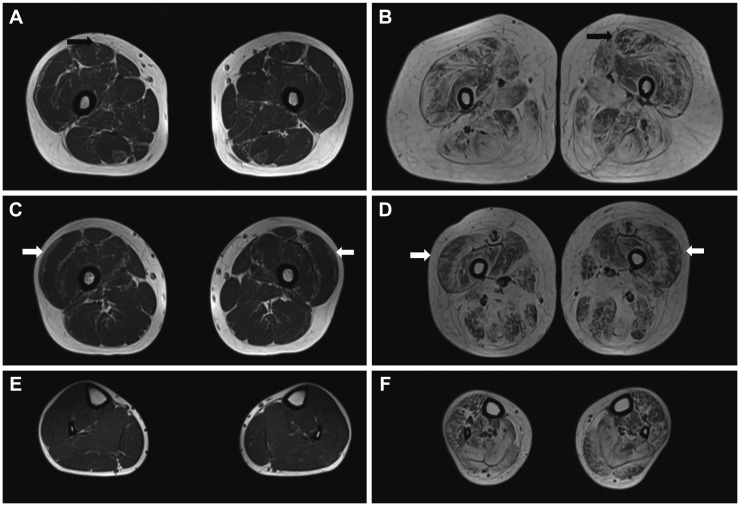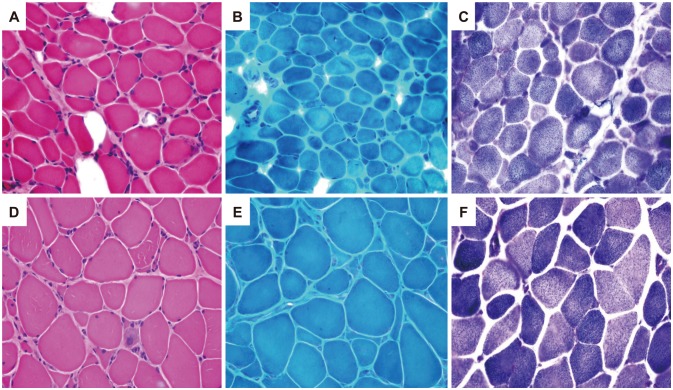J Clin Neurol.
2017 Oct;13(4):331-339. 10.3988/jcn.2017.13.4.331.
Clinical, Pathologic, and Genetic Features of Collagen VI-Related Myopathy in Korea
- Affiliations
-
- 1Department of Neurology, Yonsei University College of Medicine, Seoul, Korea. ycchoi@yuhs.ac
- 2Rehabilitation Institute of Neuromuscular Disease, Yonsei University College of Medicine, Seoul, Korea.
- 3Department of Neurology, Mokdong Hospital, Ewha Womans University School of Medicine, Seoul, Korea.
- 4Department of Pathology, Yonsei University College of Medicine, Seoul, Korea.
- KMID: 2392128
- DOI: http://doi.org/10.3988/jcn.2017.13.4.331
Abstract
- BACKGROUND AND PURPOSE
Mutations in collagen VI-related genes (COL6A1, COL6A2, and COL6A3) cause Bethlem myopathy (BM) and Ullrich congenital muscular dystrophy (UCMD). These were previously believed to be separate disease entities, but they are now both classified as collagen VI-related myopathies, which cover a broad clinical spectrum. We aimed to analyze the clinical, pathologic, and genetic characteristics of patients with collagen VI-related myopathy in Korea.
METHODS
We reviewed the clinical, pathologic, and genetic features in 22 patients with collagen VI-related myopathy from 13 families, as confirmed by genetic analysis of collagen VI-related genes.
RESULTS
The mean ages of the 22 patients at first symptom presentation and diagnosis were 4.5 and 24.9 years, respectively. Four patients in 4 families showed the phenotype of intermediate collagen VI-related myopathies (IM), 16 patients in 7 families had the BM phenotype, and 2 patients in 2 families presented with the typical UCMD phenotype. Based on genetic analysis, five patients (five families) comprising four with IM and one with typical UCMD had missense mutations in the triple-helical domain of COL6A1, and ten patients (four families) with BM showed exon-14-skipping mutations. Additionally, we found two novel mutations: c.956A>G (p.K319R) in COL6A1 and c.6221G>T (p.G2074V) in COL6A3.
CONCLUSIONS
Missense mutations in the triple-helical domain of COL6A1 are the most common mutations related to collagen VI-related myopathy in Korea. Patients with these mutations have a tendency toward an earlier disease onset and more severe progression compared to patients with other mutations.
Keyword
MeSH Terms
Figure
Cited by 1 articles
-
Novel recessive mutations of COL6A1 identified in the early severe phenotype of ullrich congenital muscular dystrophy
Young-Eun Park, Jin-Hong Shin, Hyang-Sook Kim, Dae-Seong Kim
Ann Clin Neurophysiol. 2018;20(2):89-92. doi: 10.14253/acn.2018.20.2.89.
Reference
-
1. Lampe AK, Bushby KM. Collagen VI related muscle disorders. J Med Genet. 2005; 42:673–685. PMID: 16141002.
Article2. Bönnemann CG. The collagen VI-related myopathies: muscle meets its matrix. Nat Rev Neurol. 2011; 7:379–390. PMID: 21691338.
Article3. Foley AR, Quijano-Roy S, Collins J, Straub V, McCallum M, Deconinck N, et al. Natural history of pulmonary function in collagen VI-related myopathies. Brain. 2013; 136:3625–3633. PMID: 24271325.
Article4. Briñas L, Richard P, Quijano-Roy S, Gartioux C, Ledeuil C, Lacène E, et al. Early onset collagen VI myopathies: genetic and clinical correlations. Ann Neurol. 2010; 68:511–520. PMID: 20976770.
Article5. Bethlem J, Wijngaarden GK. Benign myopathy, with autosomal dominant inheritance. A report on three pedigrees. Brain. 1976; 99:91–100. PMID: 963533.6. Suh BC, Choi YC, Kim SM, Choi BO, Shim DS, Lee DH, et al. A family of Bethlem myopathy. J Korean Neurol Assoc. 2006; 24:614–617.7. Park Y, Park MS, Sung DH, Sohn JY, Ki CS, Kim DH. Ullrich congenital muscular dystrophy possibly related with COL6A1 p.Gly302Arg variant. Ann Rehabil Med. 2014; 38:292–296. PMID: 24855628.
Article8. Park YE, Kim TH, Kim HS, Kim DS. A case of sporadic Ullrich congenital muscular dystrophy caused by a COL6A1 mutation. Ann Clin Neurophysiol. 2010; 12:27–31.9. Chae JH, Vasta V, Cho A, Lim BC, Zhang Q, Eun SH, et al. Utility of next generation sequencing in genetic diagnosis of early onset neuromuscular disorders. J Med Genet. 2015; 52:208–216. PMID: 25635128.
Article10. Park HJ, Choi YC, Kim SM, Kim SH, Hong YB, Yoon BR, et al. Molecular genetic diagnosis of a Bethlem myopathy family with an autosomal-dominant COL6A1 mutation, as evidenced by exome sequencing. J Clin Neurol. 2015; 11:183–187. PMID: 25749816.11. Park HJ, Jang H, Kim JH, Lee JH, Shin HY, Kim SM, et al. Discovery of pathogenic variants in a large Korean cohort of inherited muscular disorders. Clin Genet. 2017; 91:403–410. PMID: 27363342.
Article12. Fu J, Zheng YM, Jin SQ, Yi JF, Liu XJ, Lyn H, et al. “Target” and “Sandwich” signs in thigh muscles have high diagnostic values for collagen VI-related myopathies. Chin Med J (Engl). 2016; 129:1811–1816. PMID: 27453230.
Article13. Okada M, Kawahara G, Noguchi S, Sugie K, Murayama K, Nonaka I, et al. Primary collagen VI deficiency is the second most common congenital muscular dystrophy in Japan. Neurology. 2007; 69:1035–1042. PMID: 17785673.
Article14. Pace RA, Peat RA, Baker NL, Zamurs L, Mörgelin M, Irving M, et al. Collagen VI glycine mutations: perturbed assembly and a spectrum of clinical severity. Ann Neurol. 2008; 64:294–303. PMID: 18825676.
Article15. Richards S, Aziz N, Bale S, Bick D, Das S, Gastier-Foster J, et al. Standards and guidelines for the interpretation of sequence variants: a joint consensus recommendation of the American College of Medical Genetics and Genomics and the Association for Molecular Pathology. Genet Med. 2015; 17:405–424. PMID: 25741868.
Article16. Lampe AK, Dunn DM, von Niederhausern AC, Hamil C, Aoyagi A, Laval SH, et al. Automated genomic sequence analysis of the three collagen VI genes: applications to Ullrich congenital muscular dystrophy and Bethlem myopathy. J Med Genet. 2005; 42:108–120. PMID: 15689448.
Article17. Lucioli S, Giusti B, Mercuri E, Vanegas OC, Lucarini L, Pietroni V, et al. Detection of common and private mutations in the COL6A1 gene of patients with Bethlem myopathy. Neurology. 2005; 64:1931–1937. PMID: 15955946.
Article18. Vanegas OC, Zhang RZ, Sabatelli P, Lattanzi G, Bencivenga P, Giusti B, et al. Novel COL6A1 splicing mutation in a family affected by mild Bethlem myopathy. Muscle Nerve. 2002; 25:513–519. PMID: 11932968.
Article19. Yonekawa T, Nishino I. Ullrich congenital muscular dystrophy: clinicopathological features, natural history and pathomechanism(s). J Neurol Neurosurg Psychiatry. 2015; 86:280–287. PMID: 24938411.
Article20. Giusti B, Lucarini L, Pietroni V, Lucioli S, Bandinelli B, Sabatelli P, et al. Dominant and recessive COL6A1 mutations in Ullrich scleroatonic muscular dystrophy. Ann Neurol. 2005; 58:400–410. PMID: 16130093.
Article21. Pan TC, Zhang RZ, Sudano DG, Marie SK, Bönnemann CG, Chu ML. New molecular mechanism for Ullrich congenital muscular dystrophy: a heterozygous in-frame deletion in the COL6A1 gene causes a severe phenotype. Am J Hum Genet. 2003; 73:355–369. PMID: 12840783.
Article22. Baker NL, Mörgelin M, Pace RA, Peat RA, Adams NE, Gardner RJ, et al. Molecular consequences of dominant Bethlem myopathy collagen VI mutations. Ann Neurol. 2007; 62:390–405. PMID: 17886299.
Article23. Pepe G, Giusti B, Bertini E, Brunelli T, Saitta B, Comeglio P, et al. A heterozygous splice site mutation in COL6A1 leading to an in-frame deletion of the alpha1(VI) collagen chain in an italian family affected by bethlem myopathy. Biochem Biophys Res Commun. 1999; 258:802–807. PMID: 10329467.
- Full Text Links
- Actions
-
Cited
- CITED
-
- Close
- Share
- Similar articles
-
- A Family of Bethlem Myopathy
- A Family of Bethlem Myopathy Caused by a Heterozygous COL6A1 Mutation
- Molecular Genetic Diagnosis of a Bethlem Myopathy Family with an Autosomal-Dominant COL6A1 Mutation, as Evidenced by Exome Sequencing
- Alteration in Extracellular Matrix Components in Preeclamptic Nephropathy
- Novel recessive mutations of COL6A1 identified in the early severe phenotype of ullrich congenital muscular dystrophy



